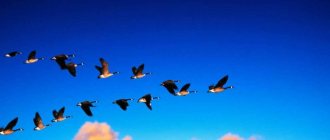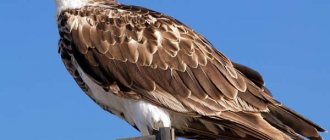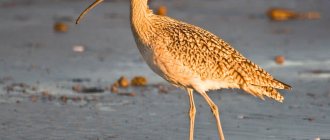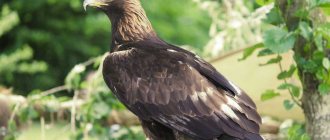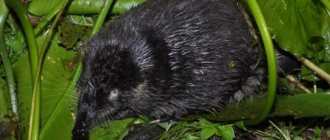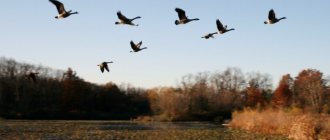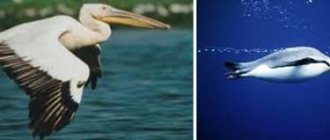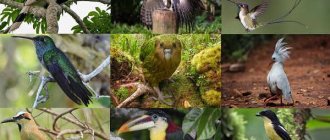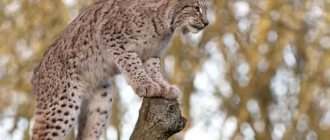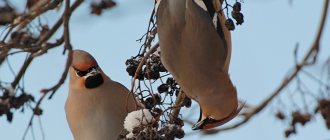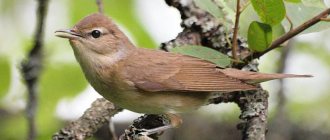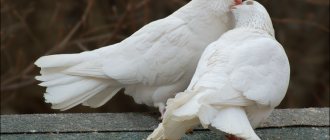The fauna of Eastern Europe is rich in untouched nature, home to a wide variety of bird species. In Belarus alone there are more than 325 species of various families and orders of birds. The avifauna of the Volgograd region includes about 300 species, and in the Donbass the list of different birds reaches 425 species.
It is not possible to list all the birds in one article, so we will focus on the most beautiful and interesting spring representatives of the avifauna. In our photo gallery you can see photos, find out the name and some features of the birds.
Stork - bird of Belarus: photo and description
Since ancient times, the white stork has been considered a harbinger of prosperity, happiness and a bird of fate. They believed that harmony, prosperity and happiness would come to the house on which the white stork had built its nest. The habitat of this beautiful bird is wide, but it is the Belarusians, thanks to the song of the 70s “The White Stork is Flying...”, who consider it their symbol.
The proud bird is quite large in size and is distinguished by:
- sweeping wings;
- large red beak;
- red, long paws;
- snow-white plumage.
Storks have a fairly loud voice, which they only use when meeting a female. For the winter, birds fly to East Africa, South Arabia or Ethiopia.
steppe eagle
The length of this proud predator is about 75 centimeters. Its wingspan is approximately 190 cm, weight reaches 3700 g. It has dark brown plumage with a noticeable soft purple sheen. The tail is cross-striped. Juveniles are usually brighter than adult males and typically have a light brown patch on the temples. The beak of these birds is dark gray, the fingers are yellow. This bird is very easy to confuse with the Imperial Eagle. The female is noticeably larger than the male. Eagles nest on the ground, and if possible, in trees. The steppe eagle is a low-flying bird. Not aggressive towards people.
Starlings
The first harbingers of spring are starlings.
They appear already in March, look for places for nesting, sit on tree branches and begin shimmering singing, with which they attract females arriving a little later. The appearance of starlings is different:
- small sizes up to 20 cm;
- a black, long, slightly curved beak, which during the breeding season of birds changes its color to yellow;
- black plumage with a purple and green metallic sheen.
The bulk of starlings settle near populated areas in hollows and cavities of trees, wooden buildings, under roofs or in birdhouses specially prepared for them. In Belarus, the number of starlings reaches 1.5 million pairs.
Griffon vulture
The appearance is characterized by a body length of 95-105 cm, a wingspan of about 260-280 cm, and the weight of individuals reaches up to 7 kg. The griffon vulture has a bare head and a curved neck, which is sometimes covered with a sparse ashy down of bright frill-type feathers. On the top of the back the feathers are darker in color, on the bottom the feathers are lighter and reddish. The wings usually have black feathering. Legs and beak are gray. The vulture hovers on wings raised in the shape of the letter “V” (during flight, it uses rising air currents). Its tail is short and rounded. When he finds himself on the ground, he moves along it, jumping or walking. The griffon vulture is larger than most birds of prey. By type of feeding, he is a scavenger.
Rooks
Immediately after the starlings, when there is still snow on the fields, migratory birds - rooks - return from wintering. These rather large birds, 45-47 cm long, are distinguished by:
- wingspan of 88-99 cm;
- black legs;
- dark gray tip of beak;
- bare white cheeks;
- black plumage with a metallic sheen.
You can meet crow-like birds both in the city and in small villages. They nest in colonies of ten to several hundred pairs. They often feed in the fields.
Scientists have found that rooks are very smart birds, since only with the help of their beak can they create and use any tool that chimpanzees create with their hands.
What birds can be found in Minsk, and which of them is most adapted to city life?
There are 332 species of birds in Belarus, of which at least 200 can be found in Minsk, the head of the ornithology laboratory of the Scientific and Practical Center of the National Academy of Sciences of Belarus for Bioresources, Candidate of Biological Sciences Irina Samusenko told a correspondent of the Minsk-Novosti agency.
At the same time, birds of almost all families are represented in the city, with the exception of pelicans, flamingos and fritillaries (there are only a few of them in all of Belarus).
Blue-winged dove
Most of all in the republic and in Minsk there are passerine birds: house and tree sparrows, great tit, barn swallow, robin, common starling and a number of others. In winter, corvids (hooded crow, rook, magpie) are especially noticeable. And one of the most “successful” bird species that has spread throughout the world thanks to adaptation to life in populated areas is the rock pigeon. Its population in Minsk is about 160 thousand individuals, or more than 500 birds per square kilometer.
To survive in the city, not only pigeons, but also many other birds are forced to adapt to living in close proximity to humans, changing many of their natural nesting and feeding habits. Among Anseriformes, this is best achieved by the mallard and mute swan, among the storks - by the white stork and gray heron, among small passerines - by the black swift, blackbird, wood pigeon, and European finch; among the gulls - by the laughing gull, silverback, glaucous and lake gull. seagulls... The same seagulls, for example, which in the wild make their nests on sandy and pebble beaches, today nest en masse on the flat roofs of industrial enterprises and administrative buildings. And they got used to getting food from landfills, although their traditional food has always been large insects, rodents and fish.
Capital "Red Data Books"
The fourth edition of the Red Data Book of the Republic of Belarus, published in 2015, includes 70 species of birds. Almost half of them can be found in Minsk.
Of those that live throughout the year, this is primarily the handsome kingfisher.
Quite often these rare birds can be found at the Zaslavsky, Chizhovsky, and Drozdy reservoirs. Several pairs of common kestrel nest in Minsk: this falcon has chosen the roofs of high-rise buildings and technical balconies of residential buildings to build nests in the city (such cases have been seen in the South-West and on the roof of the Orbita Hotel). Lesser bittern nests used to be found on the Chizhovsky Reservoir, but now only in the Lebyazhy Nature Reserve.
The great owl, the smallest of the owls, nests in Kolodischi, but also flies into the city. Among the “Red Data Books” in Minsk you can also see the glaucous gull, corncrake, lutka, grey-cheeked grebe, black kite, peregrine falcon, great merganser, and white-backed woodpecker. Near Minsk - black-throated loon, falcon, field pipit, crested lark. While flying in the Belarusian capital, pintails, lesser spotted eagle, white-tailed eagle, white-tailed eagle, and even gray crane were observed (in spring and autumn this swamp beauty can not only be seen, but also heard).
Don't flap your wings, you'll be filmed
How many birds do we actually know? Pigeon, crow, magpie, sparrow, stork, duck, seagull, owl, tit... Alas, for most ordinary people, fingers are enough for such calculations. More “advanced” people can also remember a goose, woodpecker, starling, rook, oriole, lark, sandpiper, partridge, chaffinch, thrush, jay... But even former excellent students in biology are unlikely to count to 30–40. Why?
Firstly, we are not interested in our feathered neighbors. Secondly, we do not differentiate between them. With the general word “crow” we call all corvid birds indiscriminately - the hooded crow, the crow, the jackdaw, the rook, and even the nutcracker. With just one name, “dove,” we call the blue dove, and the duck, and the pigeon, and the turtle dove... And many are surprised to learn that the name “duck,” which, as a rule, we call only the mallard, is the most common one, including in Minsk, a representative of the duck family, - it turns out, with the same right belongs to almost two dozen more species of waterfowl - the gray duck, loot, pintail, mandarin duck, pochard, red-headed duck, large and medium-sized mergansers, whistling teal and teal...
However, today in Belarus birdwatching is becoming increasingly popular - bird watching, which has long been widespread in the countries of Western Europe and North America. Armed with binoculars, a camera and a voice recorder, amateur ornithologists travel around their country and the world either in small groups or independently, recording all the data on bird encounters in field diaries (where, when, at what time, how many birds and what species they saw ). In addition to visual observation, listening to birdsong provides important information, since many species of birds can be easier to recognize by the sounds they make.
Some Belarusian public organizations offer their assistance in birdwatching in Minsk.
The best places for bird watching in Minsk, according to Irina Samusenko, are the Botanical Garden and Chelyuskintsev Park, the Chizhovskoye, Tsnyanskoye and Drozdy reservoirs, Loshitsky Park and the local section of the Svisloch River, the Lebyazhiy Nature Reserve, Komsomolskoe Lake, Sevastopol Park, a natural monument of the Republican meaning “Dubrava”, located on the southwestern outskirts of Minsk near the village of Shchomyslitsa. But even in the courtyards of their houses, city residents, by looking closely, can make many pleasant and interesting discoveries from the life of birds.
Photo by Irina Samusenko
Cormorants
The Great Cormorant lives in Belarus, Ukraine and some European regions of Russia. This breeding migratory seabird species loves tropical, temperate climates. It lives not only on sea coasts, but also along the banks of lakes and rivers, and in wetlands. It arrives from wintering grounds in March - April, as soon as the reservoirs open.
The great cormorant is different:
- body length up to 92 cm;
- males weighing up to 3 kg;
- elongated body;
- a hook-shaped, rather long beak;
- swimming membranes between the fingers;
- black plumage;
- brownish feathers on the wings and back;
- on the sides of the neck and head there is an admixture of thin white feathers;
- at the bottom of the head there are pure white feathers.
The cormorant's voice is a jerky, hoarse croak . He serves it only during the nesting period. Cormorants feed mainly on fish. An adult can eat up to 700 grams of fish per day. Therefore, the presence of large numbers of cormorants in one body of water causes significant harm to fisheries. In some European countries this bird species is considered a game bird. Cormorant carcasses are readily eaten.
Golden eagle
The golden eagle is one of the largest predatory and omnivorous birds in Belarus. The adult male has brown plumage with golden highlights on the back of the neck and nape. The offspring have approximately the same color, but their tail is white, which is bordered by a black stripe, and on the lower surface of the wings there is a large white spot. The end of the tail of an adult eagle is slightly rounded. The golden eagle flies and soars in a position with its strong wings open horizontally. The paws have curved sharp claws with which this bird captures and kills its prey - the golden eagle never holds it in its beak.
The golden eagle's body weight is approximately 3.4-4.5 kg, and it soars at a speed of 150-190 km/h; and when it attacks a hare, fox, marmot or young goat, its speed reaches 320 km/h. Its wingspan exceeds 2 meters. While keeping an eye on its prey, this bird of prey of Belarus soars very high. The golden eagle has very good eyesight, which allows it to see a field mouse from a height of thousands of meters.
great egret
In the third ten days of March, great white herons return from wintering, which immediately populate large overgrown reservoirs in treeless areas. They live in shallow water in reed and bush thickets.
The great white heron is similar in build and size to the gray heron. However, it is distinguished by its snow-white plumage and crest on its head . In the spring, “aigrettes” (long, drawn out feathers) appear on the shoulders of an adult, which at the beginning of the 20th century served as decoration for ladies’ hats. As a result, this fashion almost led to the complete extermination of this bird species.
The rough chatter is the voice of a heron. It is quite rare to hear it. But you can admire the majestic and smooth flapping of the wings, since egrets are especially beautiful in flight.
White-tailed eagle
The white-tailed eagle is one of the largest representatives of birds of prey. Adults can reach a mass of about 6 kg and have a wingspan of about 2.5 meters. Their silhouette in flight is characterized by long and wide wings, a short tail and a forward head with a powerful beak. Adult birds (6 years and older) are brown, often a little lighter on top, with a light head and neck, a snow-white tail, a yellow beak and eyes with irises. Young eagles after leaving the nest, as a rule, are much darker, have a dark head and beak, their belly feathers are slightly lighter, and there are dark spots at the ends of the wings. In the next 2 years of life, young eagles, as a result of gradual replacement of plumage, acquire a more even color. And at the age of 3-4 years they begin to resemble adult birds, the plumage becomes more uniformly brown, the tail turns white, and the beak becomes yellowish. The lifespan of a white-tailed eagle in natural conditions can reach 30 years.
The breeding grounds of this proud bird of prey of Belarus are forests located near lakes, reservoirs, fish ponds and rivers. The main requirement for their nesting site is the presence of old and strong trees growing near water bodies, and the rare presence of people. They most often build a nest on pine, beech, alder or oak trees. Some pairs may have 2-3 nests. The main prey of the white-tailed eagle is fish and waterfowl.
Red kite
This rather rare bird of prey returns from wintering grounds in March-April. It nests in separate pairs in light pine, deciduous or mixed forests bordering ponds and open landscapes. Externally, the red kite is different:
- body length up to 74 cm;
- weighing up to 1150 g for males and up to 1350 g for females;
- deep notch on the tail;
- rusty-red light plumage;
- light feathers in the form of spots at the bottom of the wings.
Red kites build nests in tall trees . They feed mainly on carrion of vertebrates, amphibians, reptiles, small birds, mouse-like rodents, and dead fish.
In recent years, this bird species has become less and less common in Belarus and other countries and regions of Eastern Europe. That is why the Red Kite is included in the Red Book.
goshawk
The male of this bird of prey of Belarus is smaller than the female (his body weight is about 640 g, his wingspan is about 90 cm). The back is dark gray in color, the belly is red with gray feathers arranged in longitudinal lines. During flight, it can be recognized by its short, rounded wings and long tail with four visible longitudinal stripes. The female looks the same in flight (usually 240 g heavier than the male). The span of its huge wings is about 100 cm, its belly is more whitish in color.
Birds of prey in Belarus, photos of which are presented in this article, are divided into migratory and wintering. The goshawk is a migratory predator; after winter, in March, it returns to its nesting territory. In May or June, 4 or 6 eggs appear in the nest. After 33 days of laying, young chicks hatch. As a rule, they leave the nest only after 4-5 weeks.
